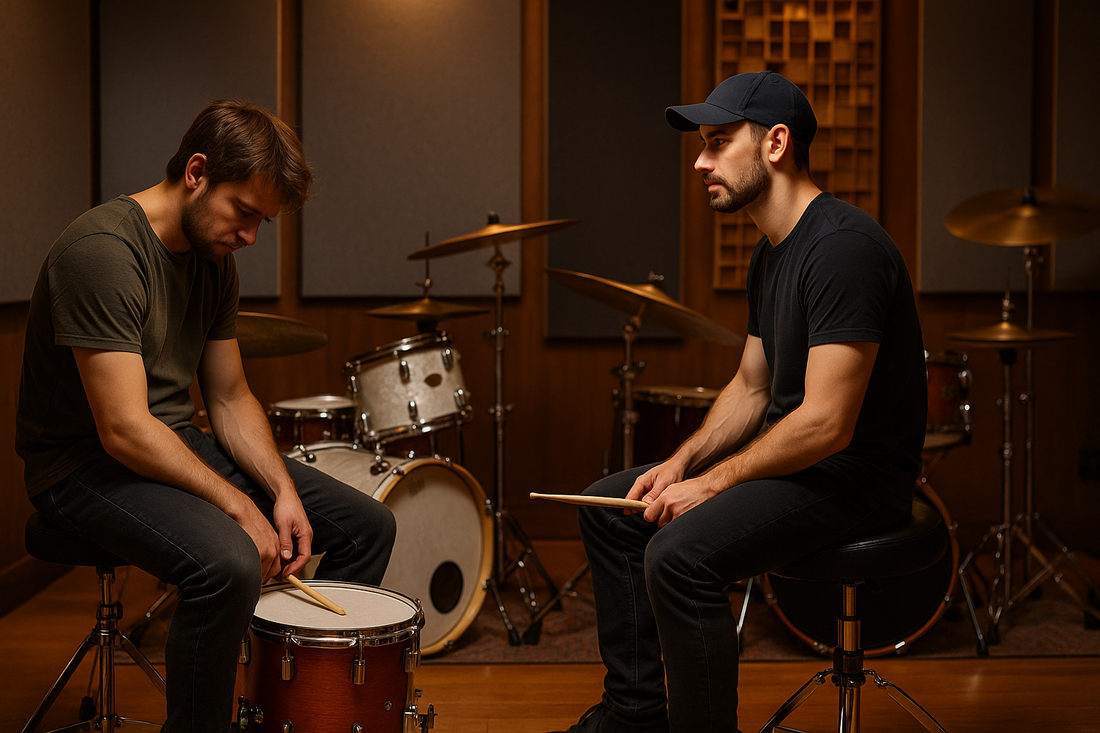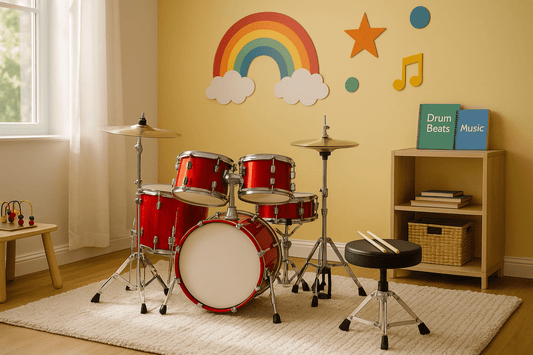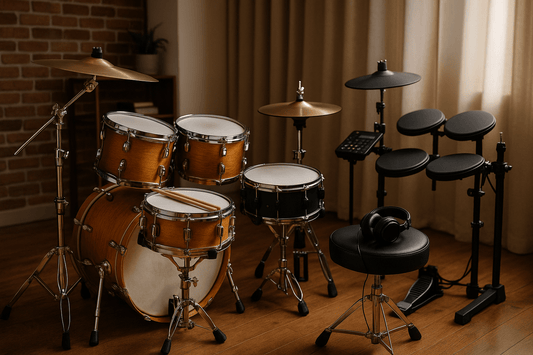Introduction
Why Your Drum Stool Matters More Than You Think
Drummers often obsess over cymbal brands and snare tone—but many overlook the one piece of gear they use more than anything else: the drum stool. Whether you’re practicing in your garage or performing for a crowd, you spend 100% of your drumming time sitting. So, choosing the right stool can make or break your experience behind the kit.
The right stool affects everything: your posture, pedal control, endurance, and even injury prevention. And one of the most fundamental decisions you’ll face is whether to go with a fixed or adjustable drum stool.
This article dives into the core differences between the two, outlining real pros and cons, breaking down how they perform across various playing styles, and offering practical buyer advice. Whether you’re a beginner buying your first throne or a seasoned pro rethinking your setup, this guide will help you make a confident choice.
Common Struggles Drummers Face With the Wrong Stool
It’s all too common: you start a session and 30 minutes in, you’re shifting around, adjusting your seat, or stretching out your back. Sound familiar? These issues aren’t caused by your playing—they’re caused by a mismatch between your body and your stool.
Some drummers sit too high and lose power. Others too low and get cramps. For those stuck with a fixed-height seat, the inability to tweak the height often leads to fatigue and even injury. Meanwhile, adjustable stools offer solutions—but can also introduce complexity or cost more.
By comparing these options side-by-side, you’ll finally answer that one nagging question: which stool actually fits your style, body, and goals best?
Understanding Drum Stool Types
What Are Fixed Drum Stools?
Fixed drum stools are the classic, no-frills seating option. As the name suggests, their height is set at a fixed level, usually predetermined by the manufacturer. Some offer limited tweaks by manually changing legs or bolts, but they don’t support on-the-fly adjustments.
These stools are typically:
-
Lightweight and compact
-
Simple to assemble and use
-
Found in beginner kits or as budget alternatives
They’re often favored by teachers who want a consistent height, or by hobbyists who only need a stool for short practice sessions. But while they offer simplicity, they lack flexibility—and that can be a problem for drummers with unique physical needs or varying setups.
What Are Adjustable Drum Stools?
Adjustable drum stools allow drummers to customize their seat height (and sometimes tilt) with mechanisms like:
-
Hydraulic lifts (gas-lift with lever control)
-
Spindle adjustments (twist-to-raise/lower with memory locks)
-
Multi-angle seat plates (for tilt control)
They’re designed to give players more control over posture and performance, especially valuable in live or studio environments where ergonomics are key.
Common features include:
-
Height markers or memory locks for quick, repeatable setups
-
Sturdy build to accommodate frequent adjustments
-
Cushioned ergonomic seats for long sessions
Adjustable thrones are widely used by professional drummers who demand consistency, comfort, and flexibility across gigs, genres, and settings.
Core Differences in Design and Function
| Feature | Fixed Drum Stool | Adjustable Drum Stool |
|---|---|---|
| Height | Fixed | Customizable (43–65cm) |
| Portability | Very portable | Can be heavier or bulkier |
| Comfort | Basic padding | Ergonomic, cushioned options |
| Durability | Simple, very durable | May need occasional maintenance |
| Price | Affordable | Mid-to-premium price range |
| Best Use Case | Beginners, short sessions | Gigging, studio work, posture support |
Understanding these basics is the first step in making the right choice. In the next sections, we’ll explore the real-world advantages and limitations of each option.
Benefits of Adjustable Drum Stools
Custom Height Settings for Every Player
One of the biggest advantages of adjustable drum stools is personalized height control. No two drummers are built the same. Leg length, torso proportions, and playing style all influence what your optimal sitting position should be. With an adjustable stool, you’re not locked into a one-size-fits-all design.
Hydraulic and spindle-style thrones let you raise or lower your seat until your thighs are at a comfortable downward angle, which:
-
Prevents hip strain
-
Improves blood circulation
-
Enhances kick pedal control
-
Promotes better posture and breathing
Drummers often fine-tune their height across different playing situations. For example, you may want to sit higher for jazz brushwork or lower for double-kick metal setups. The flexibility to dial in your perfect position is a game-changer.
For players switching between acoustic and electronic kits, or those who share gear with other drummers, adjustable thrones are also far more versatile and efficient.
Adapting to Different Kits and Environments
Touring drummers or those who frequently play gigs know that no two setups are exactly alike. Stage height, riser conditions, and even drum kit size can all vary from night to night. An adjustable stool ensures you always maintain your preferred playing position regardless of what changes around you.
Adjustable thrones also make it easier to adapt quickly:
-
Tight stages? Lower your seat for compact posture.
-
Bigger kit layout? Raise slightly for a better reach.
The memory lock feature on many adjustable thrones, like those found in the Tempo Gear T32 Stool or DW Airlift series, lets you keep your ideal height even during transport and setup—saving time and reducing error.
Ergonomic Support and Health Benefits
An often underrated benefit of adjustable thrones is how they support long-term physical health. By giving you the ability to tailor your setup, they reduce the risk of:
-
Chronic lower back pain
-
Sciatic nerve compression
-
Muscle fatigue during long sets
-
Postural misalignment
Many ergonomic thrones—such as the Ahead Spinal-G—feature adjustable elements designed in collaboration with physiotherapists. These options allow for micro-adjustments in height and angle, ensuring spinal alignment and weight distribution remain ideal throughout your playing session.
For older players or those recovering from injury, this level of control can be the difference between continuing to play and having to quit.
Drawbacks of Adjustable Stools
Mechanical Complexity and Maintenance
With extra features come extra responsibilities. Adjustable thrones, especially hydraulic ones, can suffer from:
-
Leaky cylinders
-
Worn spindle threads
-
Loose height locks
-
Squeaky or unstable joints over time
These issues aren’t deal-breakers, but they do require regular inspection and maintenance. If you’re not careful, a loose memory lock or a stuck height pin could disrupt your set—or worse, lead to an accident on stage.
Some users also report frustration with thrones that gradually lower during use (especially budget hydraulics). That’s why choosing a trusted brand with quality build materials is so important.
Cost Considerations
Let’s be honest—adjustable drum stools often cost significantly more than fixed ones. While you can find budget-friendly models like the Tempo Gear T32 under $100 AUD, most premium thrones range from $300 to $600+.
This higher price reflects:
-
Better materials
-
Ergonomic design
-
Long-term durability
-
Customization features
For newer drummers or those on a tight budget, this can be intimidating. However, it’s worth viewing it as a health investment. Comfort equals more playing time. More playing time equals more progress.
Still, if your needs are basic or your sessions are short, adjustable may be more than you require—which is where fixed stools still have a place.
Benefits of Fixed Drum Stools
Simple Design, Reliable Structure
What fixed drum stools lack in customization, they make up for in simplicity and durability. These stools have no moving parts, which means:
-
Less can go wrong
-
Setup is instant
-
Weight is minimal
-
Maintenance is almost zero
They’re ideal for practice spaces, classrooms, or quick gigs, especially if multiple drummers rotate through the same kit. Fixed thrones are also great as backup gear—something you can throw in the car and forget about until you need it.
For drummers who always sit at the same height and don’t need to make on-the-fly changes, fixed stools offer a solid and practical solution.
Lightweight and Portable
If you’re constantly on the move, playing small venues, teaching lessons, or traveling light, a fixed drum stool is a dream to transport. Most weigh significantly less than their adjustable counterparts and fold or disassemble more easily.
This mobility makes them:
-
Ideal for street performers or buskers
-
A favorite for teachers moving between student homes
-
A smart second stool for quick rehearsals or cramped venues
You’ll never worry about cylinders failing or adjusting locks mid-gig. Just grab it and go.
Budget-Friendly Options for Beginners
Let’s face it—not everyone needs a $500 throne. For students, hobbyists, or drummers on a tight budget, fixed thrones offer an affordable entry point.
Many entry-level kits come with fixed stools included. While they’re not as plush or tailored, they do the job for short sessions or learners still developing proper posture and technique.
However, even within fixed stools, quality matters. Look for thick padding, a wide base, and solid metal construction—not plastic hardware.
Drawbacks of Fixed Stools
Limited Customization and Fit
The most glaring downside to fixed drum stools is their one-size-fits-all nature. Your height is locked. Your angle is set. If that height doesn't match your body or your kit configuration, you're stuck compromising comfort and technique.
This lack of flexibility can:
-
Force unnatural leg or back positioning
-
Cause strain over longer sessions
-
Lead to uneven balance, which affects timing and control
-
Limit your ability to adapt when switching kits
While some fixed stools allow minor tweaks (via leg adjustments or bolt slots), they can’t match the precision and on-the-fly adjustability of hydraulic or spindle-based models.
Risk of Long-Term Discomfort
Over time, using a throne that doesn't suit your body can lead to:
-
Chronic fatigue
-
Poor posture
-
Back, hip, or tailbone pain
Especially during long rehearsals or performances, the inability to adjust height or seat angle becomes more than just an annoyance—it becomes a health risk.
If you frequently find yourself:
-
Adjusting your posture mid-session
-
Experiencing tingling or numbness in your legs
-
Needing frequent breaks from sitting
…it may be a sign that your fixed stool isn’t cutting it.
Playing Styles and Stool Performance
Rock and Metal Drummers – Power and Stability Needs
Rock and metal drummers often play fast, loud, and hard. This means a stool must be:
-
Extremely stable
-
Firmly cushioned
-
Positioned for optimal foot control
Most pros in these genres choose adjustable thrones like the DW Airlift or Roc-N-Soc Nitro, which allow for slight forward tilts and exact height dialing. This improves kick response, stamina, and control during double bass work or fast hi-hat grooves.
Jazz and Fusion Drummers – Flexibility and Movement
Jazz and fusion drummers often move around the kit fluidly and use more subtle dynamics. For these players, the throne needs to allow:
-
Freedom of motion
-
Smooth torso rotation
-
Low-resistance rebound for expressive control
An adjustable throne helps these drummers fine-tune their playing posture and stay relaxed. Some prefer round seats for maximum mobility, while others use tilted setups to match more open kit layouts.
Studio Musicians – Comfort and Repeatability
Studio drummers often sit for hours during tracking sessions. Here, comfort and consistency are crucial. A stool that can maintain your exact height and feel across multiple days ensures:
-
Muscle memory stays sharp
-
Fatigue is minimized
-
Session quality remains high
Adjustable thrones with memory locks and ergonomic designs are ideal here—saving time and promoting long-term comfort.
Gigging Drummers – Setup Speed and Portability
Gigging players prioritize two things: quick setup and reliable comfort. In small clubs, church gigs, or shared stages, the ability to set your stool height instantly can make or break your performance prep.
Hydraulic thrones excel in this setting. However, if weight is a concern, foldable fixed thrones with thick padding can be a great lightweight alternative.
Expert Opinions: What Pro Drummers Prefer
Insights from Touring and Studio Pros
Most professional drummers lean heavily toward adjustable thrones. They cite the ability to:
-
Match their stool to different kits
-
Maintain ergonomic health
-
Prevent injuries from long gigs
Drummers like Vinnie Colaiuta, Chad Smith, and Benny Greb all endorse advanced adjustable models with specific seat shapes and height control. They view the throne as a vital performance tool—not just a seat.
As one touring pro put it: “If your seat isn’t perfect, your whole kit falls apart around it.”
Teaching Perspectives from Drum Coaches
Drum instructors also advise students to start learning on adjustable thrones. Why? Because developing good posture and balance early on prevents bad habits that are hard to unlearn.
Many teachers recommend:
-
Affordable but adjustable models like the Tempo Gear T32 Premium
-
Spindle locks for older students who want consistent seat height
-
Contoured cushions for better spinal alignment
The consensus? The best throne is one that supports your goals, your body, and your journey as a drummer.
Feature Comparison Table: Adjustable vs Fixed Stools
Here’s a side-by-side breakdown to make your decision easier:
| Feature | Adjustable Drum Stool | Fixed Drum Stool |
|---|---|---|
| Height Control | Fully customizable (hydraulic/spindle) | Single preset height |
| Comfort | Ergonomic, cushioned for long sessions | Basic foam, less long-term support |
| Portability | Moderate to heavy | Lightweight and compact |
| Price | $100–$600+ | $40–$100 |
| Ideal For | Gigs, studios, touring pros | Beginners, backup gear, light users |
Top Models for Each Category
Best Adjustable Drum Stools in 2025
If you’re leaning toward adjustability, these thrones are widely regarded for their performance, comfort, and reliability:
-
Ahead Spinal-G Throne
-
Split-seat ergonomic design to relieve spinal pressure
-
Hydraulic and spindle versions available
-
Ideal for drummers with back issues or long sessions
-
Price: ~$539 AUD
-
-
DW 9000 Series Airlift Throne
-
Pneumatic adjustment with memory lock
-
Tractor-style seat for enhanced thigh support
-
Built for stability in heavy-hitting and pro-touring situations
-
Price: ~$599 AUD
-
-
Tempo Gear T32 Premium Adjustable Stool
-
Affordable and ergonomic
-
Hydraulic height range: 43–65cm
-
Lightweight and portable—ideal for beginners and gigging drummers
-
Price: ~$89.95 AUD
-
-
Roc-N-Soc Nitro
-
Gas shock absorber for bounce and impact reduction
-
Breathable seat for sweaty sessions
-
Excellent balance between comfort and performance
-
Price: ~$518.84 AUD
-
Each of these stools offers unique features, but all of them prioritize ergonomic design and long-term drumming health.
Best Fixed Drum Stools for Budget and Simplicity
For those who prefer minimal setup and maximum portability, these fixed thrones are the best in their class:
-
Gibraltar 5608 Drum Throne
-
Fixed height with round padded seat
-
Double-braced legs for solid base
-
Lightweight and highly durable
-
Price: ~$89–$109 AUD
-
-
Mapex T270A
-
Budget-friendly entry throne
-
Compact, cushioned, and ideal for practice
-
Non-slip feet and basic round seat
-
Price: ~$79 AUD
-
-
Pearl D50 Drum Throne
-
Entry-level fixed seat with vinyl covering
-
Sturdy and portable
-
Often included with starter kits but holds up well solo
-
Price: ~$69 AUD
-
Fixed stools are best for:
-
Drummers with consistent kit setups
-
Teaching environments
-
Players who need a second or travel throne
Buyer Tips Based on Your Needs
How to Choose Based on Body Type and Technique
If you're tall, look for stools with extended height ranges—most adjustable thrones cover 43–65cm. Round or saddle-style seats work well depending on thigh support needs.
Shorter drummers may benefit from memory locks to maintain lower heights. Avoid oversized thrones that force awkward leg angles.
If your technique involves a lot of footwork (double kick, fast hi-hats), prioritize stability and height flexibility. A throne that slips even a little will disrupt your entire lower-body rhythm.
For players who sit and play for hours—like studio or church drummers—comfort and ergonomic seat design should outweigh price concerns.
When to Upgrade from a Fixed to Adjustable Model
Here are signs you’ve outgrown your fixed stool:
-
You’re experiencing back or hip discomfort during or after playing
-
Your drumming style or kit setup has changed
-
You need more height flexibility across venues or gear
-
Your sessions are getting longer and you need better support
-
You’ve improved and want gear that evolves with your technique
Upgrading to an adjustable model is a smart move when your throne becomes a limitation rather than a support system.
Conclusion: What’s Right for You?
Choosing between an adjustable and a fixed drum stool isn’t about one being better—it’s about what’s better for you.
If you’re just starting, need a reliable backup, or play shorter sessions, a fixed stool offers simplicity and affordability. But if you want more control, better comfort, and support for longer or more complex playing, an adjustable throne is the superior investment.
Listen to your body. Think about your drumming future. Then choose the throne that’ll support your passion—literally and figuratively—for years to come.
FAQs
1. Can fixed stools work for tall or short drummers?
Only if the preset height aligns well with your proportions. Otherwise, adjustable models are better for dialing in posture comfort.
2. Are adjustable stools more prone to breaking?
They can wear out over time, especially hydraulic models, but well-made thrones with proper maintenance last years.
3. What’s the most comfortable seat shape?
Motorcycle-style or split seats are usually the most comfortable for long play. Round seats offer better mobility but less support.
4. How often should I replace my drum stool?
Typically every 3–5 years, or sooner if you notice discomfort, cushion compression, or hardware failure.
5. Do pro drummers use fixed stools?
Rarely. Most professionals prefer adjustable thrones for flexibility, posture health, and consistency across various gigs.




